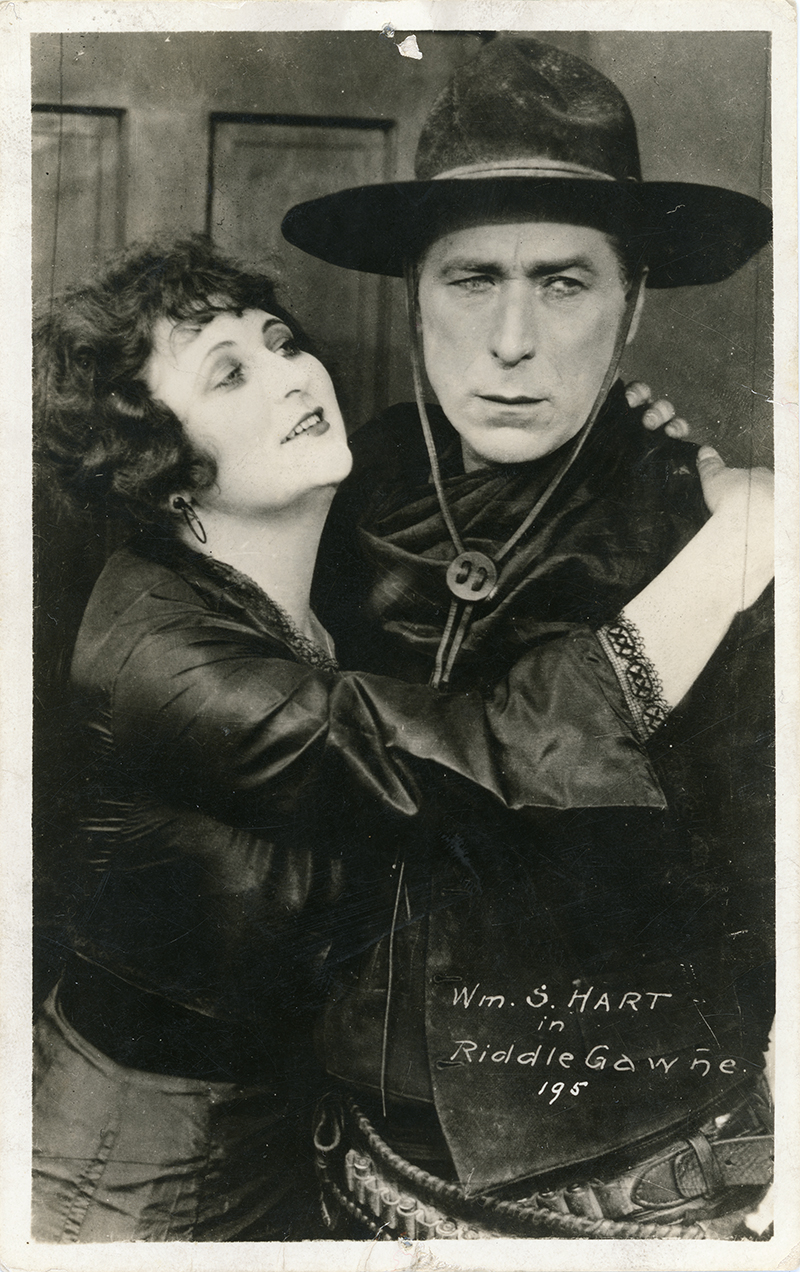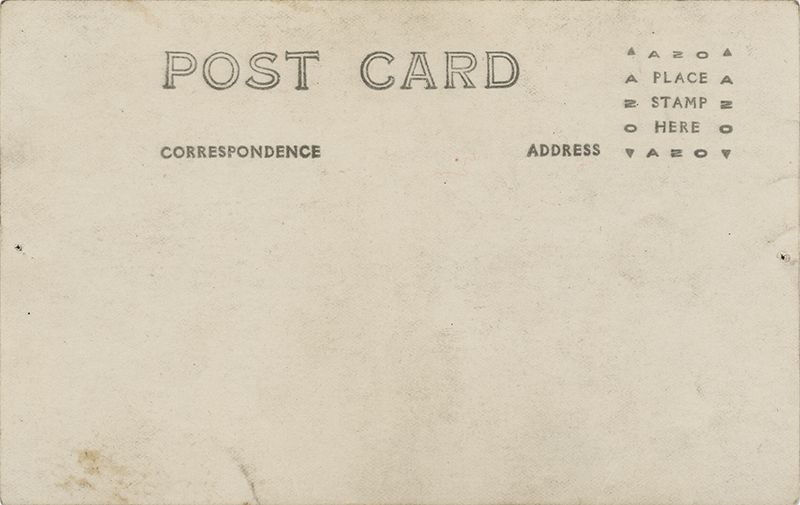"Riddle Gawne"
Starring William S. Hart

Click image to enlarge
| Download archival scan
Katherine MacDonald (as Kathleen Harkness) lusts after the dashing albeit elusive William S. Hart (as Jefferson "Riddle" Gawne). The truth was the other way around. Photograph, numbered 195, printed as a real photo postcard. Its publication probably coincided with the picture's release on August 3, 1918. The postcard is undated, but the stamp box on the back (below) shows it is printed on Eastman Kodak's AZO paper, with four arrows — two pointing up and two pointing down. This variety was used from 1918-1930.
Hart portrays the title character who is determined to avenge the murder of his brother and the abduction of the love interest (Katherine MacDonald) by the villain Hame Bozzam, played by Lon Chaney ("The Hunchback of Notre Dame," "The Phantom of the Opera"). Filming took place from June 14 to July 14, 1918, primarily at Brent's Crags in the Santa Monica Mountains near today's Malibu Creek State Park. According to Davis 2003:119, "The [movie] company camped out for three weeks in June 1918 at Brent's Crags. ... The men slept in tents and ate from tin dishes food that a cowboy cook prepared for them." (Readers will note that Davis' book errs in the location of Brent's Crags.) Davis continues (pp. 119-120):
With "Riddle Gawne" Hart began the practice that he would repeat many times: he proposed marriage to his leading lady, in this case the lovely Katherine MacDonald.
Convinced that he was in love with MacDonald, Hart asked her to marry him a dozen times without success. Those who knew Hart best found his many proposals humorous, and no one,
including the ladies involved, was sure how serious he was.
Three years later, one of them took him seriously. The 57-year-old actor's whirlwind marriage in late 1921 to the 23-year-old starlet Winifred Westover was over by early 1922. Evidently Hart kept up his friendship with Katherine MacDonald; she attended the formal unveiling in 1924 of the James Montgomery Flagg portrait of Hart that now hangs in the Hart Mansion in Newhall and "made a fuss over him" (Flagg 1925:165).
About Riddle Gawne. From Koszarski 1980:94 Produced by William S. Hart Productions; advertised as "supervised by Thomas H. Ince;" distributed by Paramount-Artcraft; released August 19, 1918; ©August 3, 1918; five reels (4757 feet). Directed by William S. Hart; screenplay by Charles Alden Seltzer from his story "The Vengeance of Jefferson Gawne;" photographed by Joe August; art director, G. Harold Percival; assistant director, Lambert Hillyer. CAST: William S. Hart (Jefferson "Riddle" Gawne); Katherine MacDonald (Kathleen Harkness); Lon Chaney (Hame Bozzam); Gretchen Lederer (Blanche Dillon); Gertrude Short (Jane Gawne); E.B. Tilton (Colonel Harkness); Milton Ross (Reb Butler); George Field ("N-----" Paisley); Leon Kent (Jess Cass). SYNOPSIS: Riddle Gawne vows vengeance on the man who killed his brother and ran away with his faithless wife. He rescues Kathleen, a girl of refinement, from two cattle rustlers belonging to a band led by Hame Bozzam, and they fall in love with each other. Bozzam, jealous, has Gawne shot. Blanche, a friend of Bozzam, nurses Gawne, and contrives to poison Kathleen's mind against him. Bozzam abducts Kathleen, and Gawne follows him. In a fight, Gawne's leg is broken, and Bozzam, thinking he is dead, admits he killed Gawne's brother and stole his wife. Gawne, despite his injury, strangles him. Kathleen appears, and their love is renewed while she nurses Gawne back to health. [Moving Picture World, August 17, 1918] REVIEWS: The ordinary story of deferred vengeance is not liked by audiences of today — it is devoid of fine purpose — but Riddle Gawne is made to respond to Hart's favorite idea of character conversion, and it is so cleverly constructed that the Rivoli audience which watched it was worked up to a high pitch of excitement, according it applause at the end. Hart's interpretation of the character is manly and forceful, and there is a subtle reason for his popularity in fighting roles in this hour of battle. He looks thoroughly representative ... of the American soldier abroad, a determined character of few words and swift deeds. [Louis Reeves Harrison, Moving Picture World, August 24, 1918] Tell 'em this is Bill's latest and oil up the ticket machine. ... I don't have to tell you fellows how to put over a Bill Hart film except to tell you that this one is fully up to Bill's past standard and contains all the elements that have made him one of the "Big Four" in the entire industry as to audience appeal and established box office drawing power. [Wid's, August 18, 1918]
LW3737: 9600 dpi jpeg from original RPPC purchased 2020 by Leon Worden.
|




